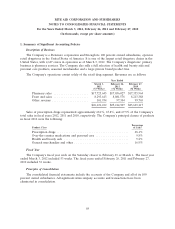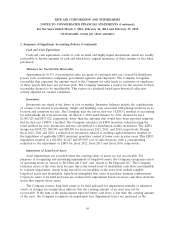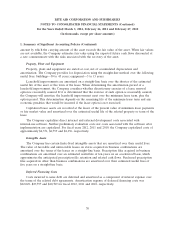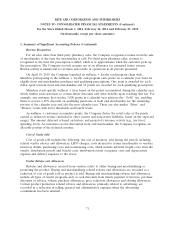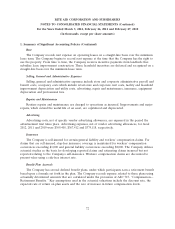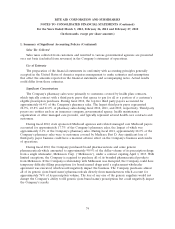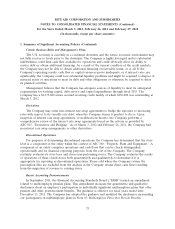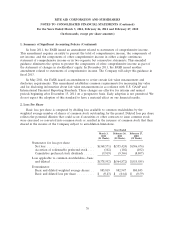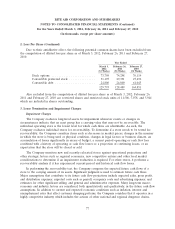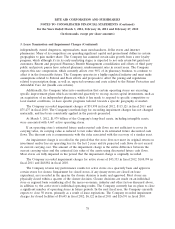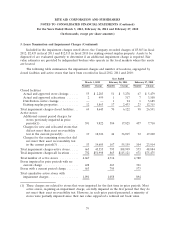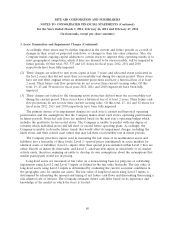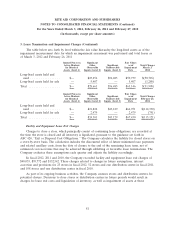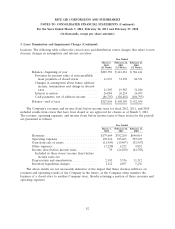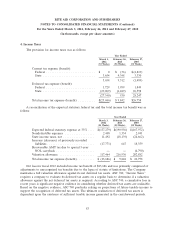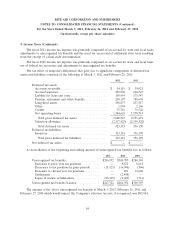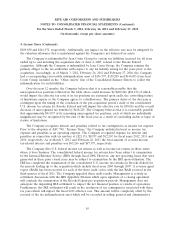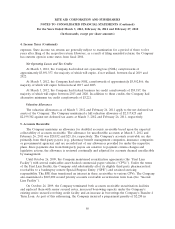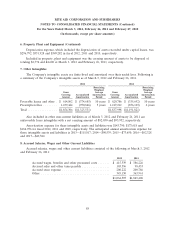Rite Aid 2012 Annual Report Download - page 78
Download and view the complete annual report
Please find page 78 of the 2012 Rite Aid annual report below. You can navigate through the pages in the report by either clicking on the pages listed below, or by using the keyword search tool below to find specific information within the annual report.RITE AID CORPORATION AND SUBSIDIARIES
NOTES TO CONSOLIDATED FINANCIAL STATEMENTS (Continued)
For the Years Ended March 3, 2012, February 26, 2011 and February 27, 2010
(In thousands, except per share amounts)
3. Lease Termination and Impairment Charges (Continued)
independently owned drugstores, supermarkets, mass merchandisers, dollar stores and internet
pharmacies. Many of its competitors are spending significant capital and promotional dollars in certain
geographies to gain market share. The Company has assumed certain sales growth from a new loyalty
program, which although it’s in its early marketing stages, is expected to not only retain but gain loyal
customers. Recent and proposed Pharmacy Benefit Management consolidation and efforts of third party
public and private payers have reduced pharmacy reimbursement rates in recent years. The Company
expects this rate compression, which currently affects over 96% of its pharmacy business, to continue to
affect it in the foreseeable future. The Company operates in a highly regulated industry and must make
assumptions related to Federal and State efforts and proposals to affect the pricing and regulations
related to prescription drugs, as well as, expected revenues and costs related to the Patient Protection and
Affordable Care Act (health care reform).
Additionally, the Company takes into consideration that certain operating stores are executing
specific improvement plans which are monitored quarterly to recoup recent capital investments, such as
an acquisition of an independent pharmacy, which it has made to respond to specific competitive or
local market conditions, or have specific programs tailored towards a specific geography or market.
The Company recorded impairment charges of $51,998 in fiscal 2012, $115,121 in fiscal 2011 and
$75,475 in fiscal 2010. The Company’s methodology for recording impairment charges has not changed
materially, and has been consistently applied in the periods presented.
At March 3, 2012, $1.979 billion of the Company’s long-lived assets, including intangible assets,
were associated with 4,667 active operating stores.
If an operating store’s estimated future undiscounted cash flows are not sufficient to cover its
carrying value, its carrying value is reduced to fair value which is its estimated future discounted cash
flows. The discount rate is commensurate with the risks associated with the recovery of a similar asset.
An impairment charge is recorded in the period that the store does not meet its original return on
investment and/or has an operating loss for the last 2 years and its projected cash flows do not exceed
its current carrying cost. The amount of the impairment charge is the entire difference between the
current carrying value and the estimated fair value of the assets using discounted future cash flows.
Most stores are fully impaired in the period that the impairment charge is originally recorded.
The Company recorded impairment charges for active stores of $43,353 in fiscal 2012, $108,999 in
fiscal 2011 and $48,884 in fiscal 2010.
The Company reviews key performance results for active stores on a quarterly basis and approves
certain stores for closure. Impairment for closed stores, if any (many stores are closed on lease
expiration), are recorded in the quarter the closure decision is made and approved. Most stores are
physically closed within a quarter of the closure decision. Closure decisions are made on an individual
store or regional basis considering all of the macro-economic, industry and other factors discussed above,
in addition to, the active store’s individual operating results. The Company currently has no plans to close
a significant number of operating stores in future periods. In the next fiscal year, the Company currently
expects to close 50 stores, primarily as a result of lease expirations. The Company recorded impairment
charges for closed facilities of $8,645 in fiscal 2012, $6,122 in fiscal 2011 and $26,591 in fiscal 2010.
78


